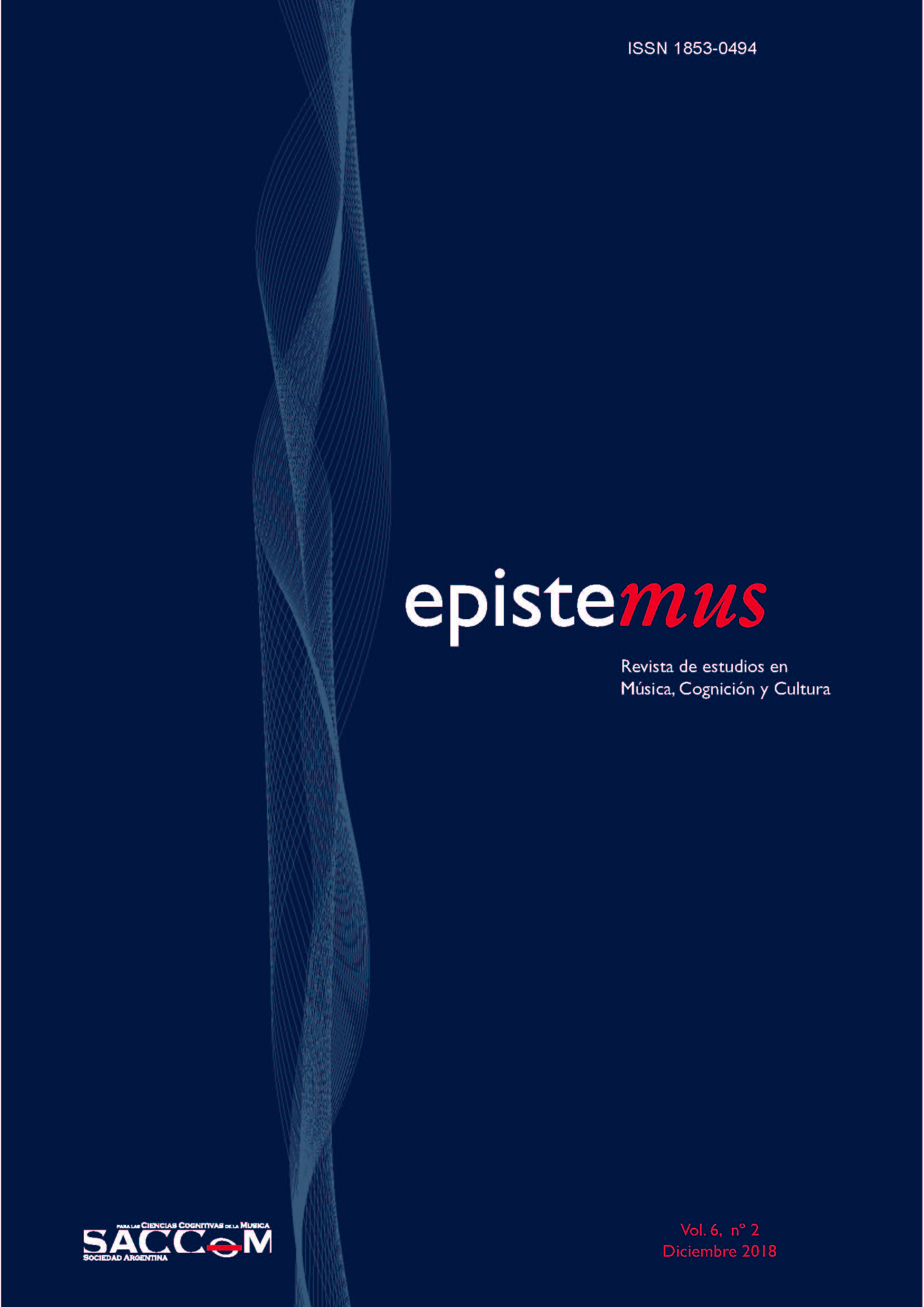Contributions of classic guitar to bolero interpretation
DOI:
https://doi.org/10.24215/18530494e017Keywords:
bolero, adaptation, classic guitar, popular musical, latin musicAbstract
One of the objectives of studying a musical instrument in academic institutions is the training of instrumentalists. The incorporation of traditional genres in this level entails the difficulty of adapting music originally performed in instrumental ensembles to a solo instrument. In this article the complementary roles of the two guitars that traditionally make up the bolero ensemble are analyzed to propose instrumental techniques so both parts can be performed by a solo guitar. The proposed techniques are the supported touch, the drawn touch, the pizzicato, the natural harmonics, the execution of a two-note melody, ligatures and supports, dragging and the use of a bar. These techniques are applied to six themes, evaluating in each case which of them best suits their musical characteristics. The contribution of this research consists in the application of instrumental techniques of the classical solo guitar for the performance of boleros, fundamental for the incorporation of this genre in academic settings.
Downloads
Metrics
References
Aguado, D. (1843). Nuevo método para guitarra. París: Schonenberger.
Arzubiaga, J. P. (2007). Apuntes sobre el bolero: desde la esclavitud africana hasta la globalización. Revista de ciencias sociales, 19, 95-117.
Barrera, A. M. (2015). Plan rectoral 2015-2019 de la Universidad de Cundinamarca generación siglo XXI. Recuperado de: https://www.ucundinamarca.edu.co/index.php/universidad/planeacion-institucional/plan-rectoral-2015-2019
Buil Tercero, P., y Hormigos Ruiz, J. (2016). Nuevas formas de distribución de la música popular en la cultura contemporánea. Revista de Ciencias Sociales, 4(1), 48-57. doi: 10.17502/m.rcs.v4i1.103
Carlevaro, A. (1966). Serie didáctica para guitarra. Cuaderno número 1. Escalas diatónicas. Buenos Aires: Barry Editorial.
Cerda, H. (2001). El proyecto de aula. Bogotá: Magisterio.
García, J. J. (2016). ¿Son o salsa? Agenda cultural Alma Mater, 233, 10-12. Recuperado de https://revistas.udea.edu.co/index.php/almamater/article/view/323454
Gardner, H. (1993). Multiple intelligences: the theory and practice. New York: Basic Books.
Londoño, M. E., y Tobón, A. (2004). Bandola tiple y guitarra: de las fiestas populares a la música de cámara. Artes, la revista, 4(7), 44-68. Recuperado de https://revistas.udea.edu.co/index.php/artesudea/article/view/22847
Nicola, I., y Pedreira, M. (2000). Método de guitarra. Primer Curso. La Habana: Atril Ediciones.
Nicola, I., y Pedreira, M. (2004). Método de guitarra. Cuarto Curso. La Habana: Atril Ediciones.
Pagano, C. (1989). El bolero en Colombia: un viejo amor. Revista Universidad Nacional, 20, 37-48. Recuperado de https://revistas.unal.edu.co/index.php/revistaun/article/view/12004
Pujol, E. (1960). El dilema del sonido en la guitarra. Buenos Aires: Ricordi Americana.
Rodríguez Arenas, M. (1964). La escuela de la guitarra. Libro III. Buenos Aires: Ricordi Americana.
Roch, P. (1921). Método moderno para guitarra (Escuela Tárrega). New York: G. Schirmer Inc.
Sánchez, D. F. (2008). Análisis técnico e interpretativo de la Cadenza del concierto para Guitarra y Pequeña Orquesta de Heitor Villalobos (Tesis de grado). Pontificia Universidad Javeriana, Colombia.
Thoms, W. J. (1846). Folklore. Athenaeum, 982. Recuperado de https://www.jstor.org/stable/41306605?seq=1
Villegas, P. (2016). Estrategia y táctica para revitalizar el bolero. Revista Cubana De Antropología Sociocultural, (7)8, 89-104. Recuperado de http://www.revista-batey.com/index.php/batey/article/view/136/89
Downloads
Published
How to Cite
Issue
Section
License
Politica vigente desde octubre de 2019
La aceptación del manuscrito por parte de la revista implica la cesión no exclusiva de los derechos patrimoniales de los/as autores/as en favor del editor, quien permite la reutilización, luego de su edición (postprint), bajo una Licencia Creative Commons Atribución-NoComercial-CompartirIgual 4.0 Internacional (CC BY-NC-SA 4.0)
Acorde a estos términos, el material se puede copiar y redistribuir en cualquier medio o formato siempre que a) se cite la autoría y la fuente original de su publicación (revista y URL de la obra), se brinde el acceso a la licencia y se indique si se realizaron cambios; b) no se utilice el material para fines comerciales.
La cesión de derechos no exclusivos implica que luego de su edición (postprint) en Epistemus los/as autores/as pueden publicar su trabajo en cualquier idioma, medio y formato; en tales casos, se solicita que se consigne que el material fue publicado originalmente en esta revista.
Tal cesión supone, también, la autorización de los/as autores/as para que el trabajo sea cosechado por SEDICI, el repositorio institucional de la Universidad Nacional de La Plata, y sea difundido en las bases de datos que el equipo editorial considere adecuadas para incrementar la visibilidad de la publicación y de sus autores/as.
Asimismo, la revista incentiva a los/as autores/as para que luego de su publicación en Epistemus depositen sus producciones en otros repositorios institucionales y temáticos, bajo el principio de que ofrecer a la sociedad la producción científica y académica sin restricciones contribuye a un mayor intercambio del conocimiento global.

















